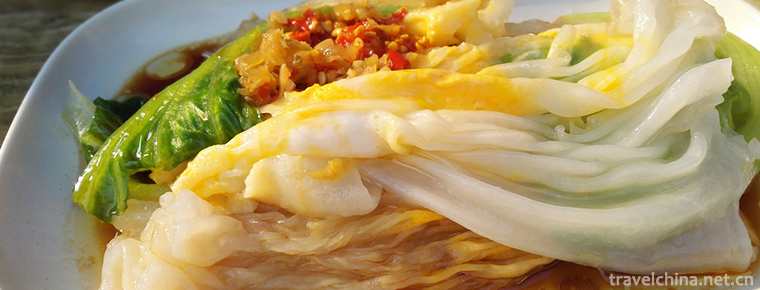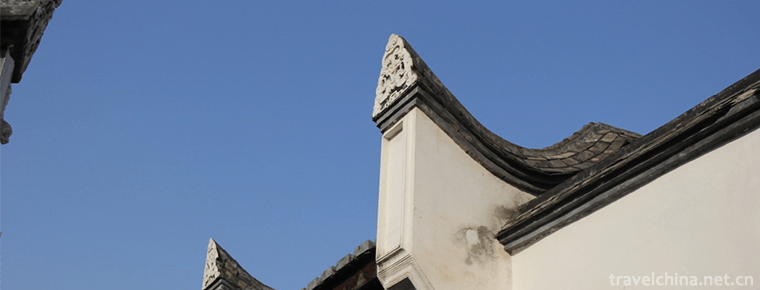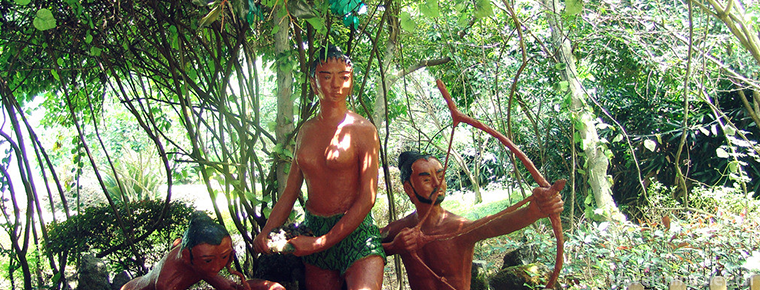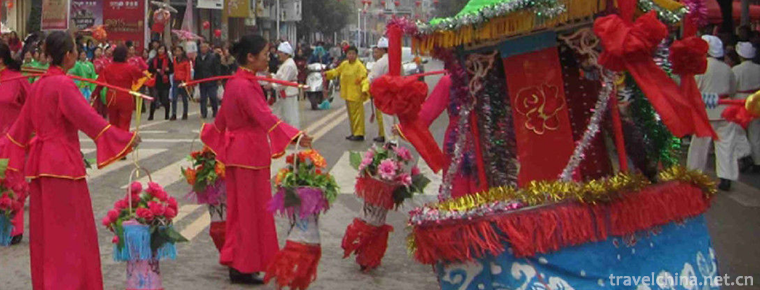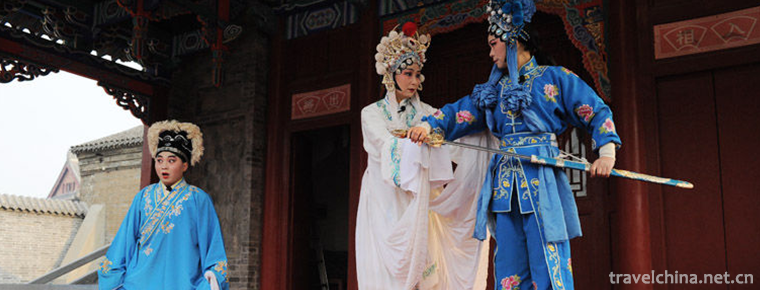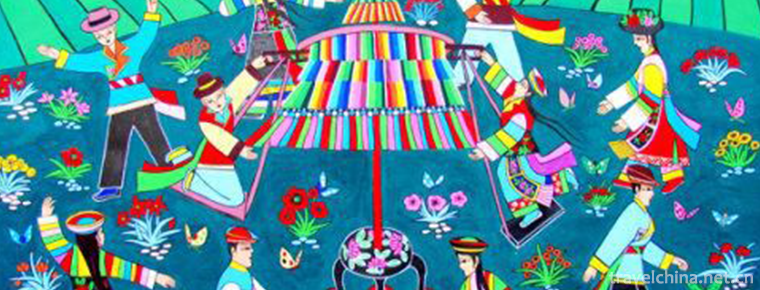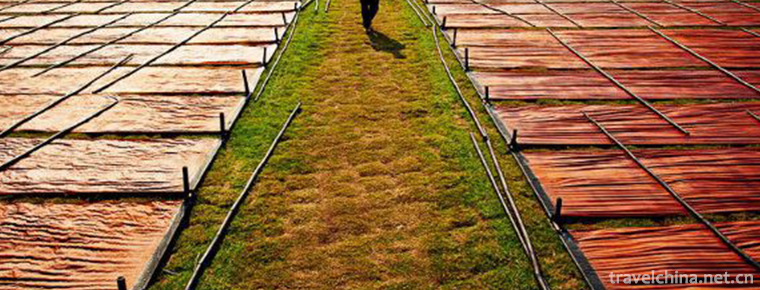Cangyan Mountain Scenic Area
Cangyan Mountain, located 50 kilometers southwest of Shijiazhuang City, Hebei Province, is located in Jinglong County. As the core scenic spot of Cangyan Mountain, Cangyan Mountain Fuqing Temple is listed as the key cultural relic protection unit of China, which is a famous historical and cultural mountain in China, a national key scenic spot, a national 4A-level tourist area and a Cangyan Mountain Fuqing Temple. The biggest characteristic of Cangyan Mountain is that it not only has beautiful natural scenery, but also has many religious temples. There are many famous temples and ancient temples in the mountains.
geographical environment
Cangyan Mountain Scenic Area covers 63 square kilometers, 1039.6 meters high and over 1000 meters above sea level. Cangyan Mountain is a branch of Taihang Mountain, with beautiful scenery, lush vegetation and scenery everywhere. It has a wonderful scenery and classical scenery. It has enjoyed the reputation of "five mountains are beautiful and graceful, and the peaks of Taihang Group are only Cangyan" since ancient times. There are many ancient trees in the Cangyan Mountains, which are verdant in succession. Among them, the "Sixteen Sceneries of Cangyan" are most famous, such as "Bijian Lingdan", "Yinyashi", "Cliff Pearl Embedded", "Fufeng Evening Light", "Hillside Qibai", "Qiaokai Other Face".
Among these peaks, there are many Zen houses, ancient temples, pavilions and steles scattered, mostly relics of the Ming and Qing Dynasties. These buildings are built on cliffs or under cliffs, with carved beams, painted buildings and ancient fragrance. The main ones are Fuqing Temple, Academy, Wanxian Hall, Princess Temple, Bridge Hall, Yuhuangding, Fenghuixuan, Tibetan Sutra Building, etc.
Bridge Hall is the most famous building in Cangyan Mountain. Seen on the two cliffs, there are three single-hole stone arch bridges overhead. There are also building halls on the bridge. Looking down from the hill, the bridge is flying over the sky, the clouds move over the building and suddenly want to fly. This temple is one of the three major hanging temples in China, and it is also a masterpiece of ancient Chinese architecture.
natural resources
The landscape of Cangyan Mountain is rich and colorful. The mountains are lofty, the rocks are craggy, the deep valleys, the ancient trees and famous trees, the clear springs and the blue lake constitute a strange, quiet and beautiful natural landscape. With a long history and outstanding architectural art, Fuqing Temple in the ancient temple of thousands of years has formed a spectacular humanistic beauty, which makes it enjoy the reputation of "Five Yues, Qixiu Range Mountain, Taihang Group Peaks are only Cangyan". Fuqing Temple was built in the early Sui Dynasty 1400 years ago. According to the inscription, Princess Nanyang, daughter of Emperor Yangdi of Sui Dynasty and Sui Dynasty, once became a monk here and spent 62 Spring and Autumn Periods. The main buildings on the mountain are academy, Wanxian Hall, Bridge Hall, Buddhist Hall, Tibetan Sutra Building, Princess Temple, Stele Pavilion and so on. All the buildings are small and exquisite. They are built on broken rocks or across dangerous walls and eaves. Their structures are magnificent and magnificent.
The core of Cangyan Mountain Scenic Spot is "Cangyan Sanju":
A unique "bridge building hall". The bridge overrides a hundred cliffs, looks up at the blue sky, and bows down to the abyss of ten thousand feet. The shape is like the open shoulder arch of Zhaozhou Bridge. Build a building on the bridge, cloud flying tower moving, built a hall in the building, three big Buddhas in the hall. It is true that "Qianzhanghongqiao looks into the sky and clouds fly together", not a fairyland is better than a fairyland, suspected to be heaven dust. Now it is one of the three major hanging temples in China.
Erju "White Sandalwood". Sandalwood is like the sea, and pedestrians are few feet in length; the flowing water is murmuring, and pavilions and pavilions are hidden in it, so it is unique and sighs as a god-worker. Sandalwood tree roots bare, hugging boulders, no skin, no heart, strange appearance, some like Mandarin ducks, some like Panlong, some like Crouching Tiger. Many trees are over one hundred years old. The oldest one is the King of Sandalwood. Its branches extend around the rice. Its trunk is hollow enough for one person to rest in the tree. It is amazing. Sandalwood trees of all sizes are covered with cangyan mountain streams. Looking at sandalwood from a distance like the sea and shading the sun from the sky is a good place for summer vacation. Three unique "ancient cypress pilgrimage". Tens of millions of thousand-year-old cliff cypress, sand cypress and cedar grow on the cliff. They grow in a variety of ways. They grow in the direction of Nanyang Princess Ancestral Hall, regardless of standing, side-out, overhanging, north-south or east-west.
Cangyan Mountain has sixteen famous sceneries. The scenery is fascinating and pleasant. For: Yanguan Lock Cui, Fengquan Shuyu, Academy noon shade, Bijian Lingdan, hanging ladder clouds, bridge hall flying rainbow, cliff beads, absolutely dedicated huilian, Valley bird song, cliff Qibai, said dangerous terrace, empty Pavilion hidden secluded, Shangshu Gujie, Yinya stone milk, Qiaokaitian Tian, Fufeng sunset.
Cangyan Mountain Temple Fair has a long history. It has a history of more than 1300 years. It is called March and October of the lunar calendar every year. The temple fair in March is especially grand, and every time this festival is crowded with pilgrims, it is very lively. Cangyan Mountain Temple Fair originated from the worship of the Virgin Lady of Cangyan. Nanyang Princess, the daughter of Emperor Yangdi of Sui Dynasty, was born in Cangyan Mountains and used the medical skills she learned in the palace to treat the local diseases and rescue the difficulties. She is full of grace and leaves many moving stories. After Nirvana, she is honored as the Virgin Lady of Lithosphere. Temple fairs have developed into a kind of folk art performances. People spontaneously organize various folk activities with Jinglong local characteristics: pulling flowers, emperor bars, lion and dragon dancing and so on.
Cangyan Mountain attracts numerous tourists from home and abroad for sightseeing, poetry and painting, and film and television scenery with its unique style of "heroic, strange, beautiful, dangerous and secluded" beauty. "Journey to the West", "Legend of the Hakka in Yiwei", "Crouching Tiger, Hidden Dragon", "White Dragon Sword", "Mummy 3", "Chicken Hair Letter", "Great Power Medicine", "Breaking War", "Mulan"... Many film and television scenes are filmed here.
Traffic information
Transportation: From Shijiazhuang City, you can take a minibus or a central bus. The fare is about 20-30 yuan, and the journey is about 2 or 3 hours.
Self driving
1. Starting from Beijing: Beijing-Shijiazhuan Expressway to Shitai Expressway, Xiulin Expressway to Cangyanshan (Beijing-Cangyanshan 272 km), Shitai Expressway to Cangyanshan intersection (No. 5) and turn right along the scenic area highway.
2. Start from Tianjin: Turn Shitai Expressway via Jinbao Expressway, Xiulin Expressway at Cangyan Mountain Exit (Tianjin-Cangyan Mountain 300 km), Shitai Expressway to Cangyan Mountain Intersection (No. 5) and turn right along the scenic area highway.
3. Starting from Taiyuan: through Shitai Expressway, under Xiulin Exit of Cangyan Mountain (Taiyuan-Cangyan Mountain 200 km), after Shitai Expressway to Cangyan Mountain intersection (No. 5), turn right along the scenic area highway.
4. Starting from Shandong Province: Turn Shitai Expressway through Qingyin Expressway, Xiulin Expressway under Cangyan Mountain Exit, and turn right after Shitai Expressway to Cangyan Mountain Intersection (No. 5) and then go straight along the scenic spot highway.
Guide for road trips
Opening hours: 9:00-16:00
Cangyan Mountain Ticket 50 yuan
Main attractions
Jinglongming is in danger, showing in lithosphere. The beauty of lithosphere lies in its strange mountains, strange rocks, strange forests and quiet surroundings. How many visitors are drunk in the mountains and left on the ancient and modern inscriptions and chants. In front of the mountain, the water cleans up the soul; in the valley, sandalwood refreshes the lungs; listens to the rhyme flowing from the good birds, and sees the valleys where the scenery is coming; treads on the suspension pedal to enter the cloud table, and strengthens the sword pavilion; crosses the flying rainbow and practices the valley, and is absolutely equal to the Dragon gate. Clouds and mists linger in myths; mountains and rivers revere. Suddenly Linbixu, fortunately there is a dangerous fence; a top Ling, even to Taoyuan. The scenery is so changeable that the famous mountains are not empty; the momentum is magnificent and the scenery is real. Written at the end of the brush, the well-known "Sixteen Sceneries of Cangyan" turns the ancient monastery forest into a picture to show.
Yan Guan lock green
Cangyan East Peak Cliff forms a mountain pass between the west-turning hillside and the west-turning hillside at half-waist. Fuqing Temple Mountain Gate is built on the mouth with the help of mountain situation, followed by Maolin and deep valley. Xifeng cliff is half a mile northwest, and together with the Luantai embankment, it forms the Luantai Pass, the mountain gate and the archway are hidden in it. Therefore, if you don't go to the entrance, you can't help seeing the mountain gate. When you enter the entrance, you still can't see sandalwood. Rock the first scene of the huge wall gently, "Yanguan Lock Cui" connects the sky.
Wind spring gargling jade
As soon as you enter Luantaikou, you can easily see that there is a valley between the north and the south, the water of Baihe Spring (Sihe) crosses the mountain gate, the rugged rocks in the beach, and the wind blows the dust on the stream. The gorge is fresh and interesting. Fuqing Temple Mountain Gate Architecture, built near the water, has stone dimples stretching into the water. Even in the dry season, the spring here is still dry. Down the hill, people drink from clear springs, and the water tastes sweet. According to legend, white cranes once lived in groups by the stream. Streams pierce through rocks and are bright and refreshing, such as rings, stone crabs in groups, and scales can be counted. "Fengquan Shuyu" purifies people's feelings.
Academy shade
From the edge of the water up, into the mountain gate, the scenery changed: a lush green eyes, Nanling such as screen and Tianqi. Dongyu is green and vague, and "the noon shade of the academy" is the foreword. On the right side of the mountain gate, under the cliff of Linxi Peak, a stone culvert was built, on which the Yuemen Gate on the rock ridge was built, and there was a house in the courtyard. Here the ancient Baisenyu, Qingxi hidden, although the noon, but also green and overcast. It is said that this quiet and tranquil place was Cangshan Academy. Therefore, it is called "the noon shade of the academy".
Bi Jian Ling Tan
Along the stone path between the academy and the round room, the valley is deep, the boulders are uneven, the jungle is overcast by the sun, and the fragrance strikes. Moon Gate is the main road, from the "Bijian Lingdan" door forehead, we can know that it has arrived in Sandalwood. The white sandalwood here, according to the records of the Song Dynasty stele, has a thousand years of tree age, it can be said that Cangshan is unique. Not only are they empty-skinned, but their tree shapes vary from place to place. On the rock walls, some are lateral, some hang upside down Zhai umbrellas; at the bottom of the river, some have holes in their trunks and are still lush; some only have curved trunks and new branches, which are rare bonsai; some are like giant pythons drilling seams and holding stones, and are eager to pull out mountains; some are densely clustered, like fierce-looking; some are like dragons tumbling over and scrambling to break down walls. It's amazing. It's rare in the world. The ancients praised them as "the true soul on the feldspar".
Suspended ladder cloud
The farther west the cliff between Nanling and Xifeng is, the narrower the distance between the cliff is. Cliff thousands of search, Qingtian line, extremely looking up, only see the bridge hall flying across the cliff north and south, Jinbi across the sky is really a wonder of the world. People marvel at it and praise it: "Qianzhang Hongqiao looks into the sky and clouds fly together". Under the Moving Eye Bridge, after the towering Shidao Bridge Hall, there are more than 300 levels of high suspension. Up the stairs, the breeze blows, cold, bold, a sudden move, at this time is really blue sky! If the clouds are low and foggy, and the cliffs are windy and cloudy, the climbers can go straight into the clouds. People call this stone "ladder" and "ladder of heaven", and call this scene "suspended ladder cloud".
Crag bead
Up to the top of the ladder, there are Lingguan Hall standing face to face. Later, the two cliffs were embedded in a slightly circular huge black stone, which hung over the top of the palace. Every time a mountain torrent falls into a waterfall, a torrent falls down and the stone disappears. Lingguan Hall was built before this stone, just in Hongkou, unexpectedly safe and sound. This strange phenomenon is very similar to the special function of black stone, so people in the past regarded it as a mountain spirit, called it "to avoid water drops", and even "mountain spirit deliberately boasts, how many celebrities as poetry"! In fact, when filling the cliff and building the ladder, the skillful craftsman intentionally left behind a secret channel to release the flood. Blackstone is just embedded in the narrowest part of the two cliffs, and together with the Lingguan Hall, it hides the dark path. Flying waterfalls are released from behind the stones, so black stones have the ability to avoid water. It is difficult to solve this strange phenomenon because the visitors can not see the Mason tunnel in their place. The spectacular flowing downward and the mysterious and invisible integration constitute the cliff Beaded scenery, which is indeed unique here. There is a legendary water curtain cave in the southeast of Lingguan Hall, which is a mountain spring overflowing from the cliff crevice.
Bridge hall flying rainbow
East of Shuixian Cave is the Temple of Heavenly Kings. People used to call it the Hall of Small Bridge Building. In front of it is the building hall of the bridge, and then the overpass. Three Bridges are flying with rainbows, so you can enjoy them. On the eaves pillar facing the Temple of Heavenly Kings hangs a couplet of big grass: "There is no lamp in front of the Hall with moonlight, and the mountain gate is not locked for cloud closure." It is really a singing of wonders and beautiful scenery. The exquisite ancient stone carvings, superb ancient craftsmanship, graceful and moving Soviet-style paintings, ridges decorated with powerful dragons, jade phoenixes, golden and brilliant ceiling, with bright red pillars, red walls, exquisite sparrows, fences... From the overpass gaze at this pair of sisters bridge hall, as if already to the Moon Palace Celestial Palace; overlooking can be seen: sandalwood under the cliff is crowded, the ascendants are few feet. Turning around, the "Bridge Hall Flying Rainbow" is spectacular!
Go back to the hurdle
On the cliff between the West peaks, Zen houses, dangerous terraces, ancestral temples, float maps, etc. stand in the air, and the trestle road built by chiseling walls is tortuous and accessible. Climbing in the meantime, the upper connection is too empty, and the lower is facing no land, such as treading on the sword pavilion. The peak turns round and goes straight to the cliff end. Looking from afar, the mountains overlap with each other, like billows of waves; Looking from afar, Baihe Spring Gorge has a panoramic view. In the past, somebody slipped and fell, so it used to be called "falling to the top". Short walls have been built at the edge of the trestle road, which is known as the "Great Mountains for Huilan". So far, tourists have been thrilled.
Ancient calligraphy of Shang Shu
The ancient monument stands on the east side of Xianhulan along the Jushan Mountains, turning north to the "peak circuit" and at the corner. This stele turtle dragon cap, 3.5 meters high, was engraved in 1527. The inscription "Cangyan Restoration of Fuqing Temple Records" is Zhao Weifan's seal for the right political participation of the Chief Secretary of Bureaucracy of Guizhou in the Ming Dynasty. The writing of inscriptions and Shudan came from Shangshu Qiaoyu, an official in Ming Dynasty. While the inscription records the restoration of the Princess True Rong Temple of Miaoyang (now Nanyang Princess Temple) in Fuqing Temple from 1516 to 1520, it describes the temple scenery seen by the author in 1525 when he visited Cangyan with Shi Liu Lin, the right deputy capital of the capital procuratorate. The full text is only 600 words, and the sentences are simple and concise. The author is Qiao Yu, a native of Xiyang County, Shanxi Province. He was born in the period of Zhengde and Jiajing, which were chaotic in the current dynasty. Historically, he was honest and rigorous in administration, especially in admonishing the emperor, so that he was forced to resign and return home. Liu Lin, Zirui, a native of Renxian County, Jiangxi Province, and Shangshu of the Ministry of Government and Industry, was one of the three famous talents in Jiangnan at that time. He is a man of equal interest to Qiao Yuzhi. A generation of eminent ministers traveled together, leaving a good story for Cangshan. The inscriptions are written by Qiao Yu at the age of 62. They are of great value in the art of calligraphy, literature and historical materials. They are famous monuments in Cangyan Mountain. Because the author once lived in the official department, the monument was called "Shangshu Gujie". The engraving of the inscriptions and the carving of the inscriptions are excellent. Tablet cap carved Panlong thoroughly, people also refer to it as "Tablet of Tablet of Tablet of Tablet of Tablet of Tablet of Tablet of Tablet of Tablet of Tablet of Tablet of Tablet of Tablet of Ta Before the founding of the People's Republic of China, monks fabricated that if they could stick coins on the tablet, they would have boys. So far, there are still many visitors who put coins on the tablet, so that the tablet has been heavily worn.
Statement of danger
There is a huge stone on the cliff wall of Xifeng, standing in the north of the Tibetan Sutra Tower, 10 meters high, resembling a solitary peak. It is flat as a bat, and the four big characters of the chessboard and Qiao Liu Yun Wo carved by the predecessors are still clearly distinguishable. According to Gujie, Qiao and Liu did come. Standing on the platform, there are countless sceneries in the southwest valley, and the sound of thunder stirs up when the mountains pass back to the valley. So there's a saying: Lingshan, where the Taoist venue opens, goes to Nanyang, Miaoyang. Bodhisattva's heart and soul are the best. He should respond to the lecture platform.
The hidden Pavilion is hidden.
Walk along the pavement under the platform and see the Nanyang Princess Temple. The ancient cypress is crooked on the oak, the pagoda stands beside the eaves, the Ficus pumila leaks its green under the fence, and the Dragon tablet accompanies the red wall. Occasionally, the Vatican Palace looms. Fairy music is played in the palace, long sleeves can be danced in the Guidian? Previous poems like "The Imperial Palace under the Rock is painted and the Qionghua purple and green pot is small and fragrant". They point out the scenery of "the empty Pavilion is hidden and secluded", which is very appropriate.
Sunset at furnace peak
On the north end of the East peak, there are also some orphans of the French platform, whose body is smaller than the French platform, and its shape is very similar to thHillside
Ling Tan is a marvelous rock, and the ancient cypress is even more remarkable here. Whether at the top of the two peaks or at the edge of the cliff top of the two valleys, ancient cypress has grown for more than a thousand years. Far-reaching clusters, not falling. What's more, they are rooted in the stone of Wanzhang cliff, stretching out all kinds of branches for people to appreciate; the most dangerous place, like dragon dance; the most open place, such as green fireworks, the clear sky in full bloom; the steepest place, like the green phoenix to spread its wings. Nowadays, people are focused and interesting. In the past, they were called "hillside cypress". The ancient cypress and Lingtan are sandalwood and verdant, which are unique and beautiful.
Yin cliff stone milk
The southeastern corner of the southeastern Valley is slightly curved, deep and densely forested, which is the most quiet place of the lithosphere. Here, the cliff wall shrinks, and the cliff top protrudes. On the huge cliff walls on the north, East and south, there are stalactites hanging all over the cliff wall. Their shapes are strange and strange. The south wall is like "Thousand Buddha Rock", the north wall is like "Water Curtain Cave", and the east wall is like "Debris Flow". People don't have to go to Shizhongshan or Qixing Cave to enjoy their creations here. This strange phenomenon is really caused by strange rock formations. Cangyan Mountain is a cliff formed by granulite. Where there is no straw or strawberry moss on the cliff, it is ochre. Therefore, the predecessors also called it "Danbi" and "Chiya". Only in the southeastern corner of the southeastern valley, the rock stratum is composed of limestone. Because the mountain torrents can not be washed out before the cliff top bursts, but the fine water often soaks. For tens of millions of years, such a strange scene has been formed. "Deep in Cuiyan, dust is suspected to be the immortal species of Yulai," the former people because of its secluded location, known as "cliff stone milk".
e incense burner. Someone put stone pillars on the top of it sometime someday as "fragrance", commonly known as "incense stove". "The first year of Song Qianxing is inscribed on the stone incense stove" in Jinglong County Records of the Republic of China, which is now not recognized. The stone incense burner is located just in front of the Princess Temple. Looking from the Princess Temple, "incense" and "incense burner" can be seen faintly. Every sunset, sunset Fufeng, "Sanxiang" more distinct.
Empty valley Birdsong
Cangstone, deep cliff, Valley ring, luxuriant forests, mountains and springs. Beautiful sunshine, rest under the forest, mountain birds chirping, singing a hundred cracks, lingering sound around the forest, intoxicated. Sweat on the ladder, breathe on the dedication, and give a loud cry. The cuckoo should be relaxed and happy.
Open your mouth.
Behind the Yuanjue Palace, on the cliff of the South Cliff, there is a cave with the inscription "Know how to open another sky". On the entrance of the cave, we can see that the words "Nantianmen" are inscribed on the cave. Entering the "gate", climbing the buttresses out of the cave, has reached the east side of Nanling, and then up, that is, Yuhuangding, the top of the Dananling Mountains. Ling absolute top, surprising: a few hectares of good fields Xiumaisha, green willow Hongtao Ying village. Several shocks, the sound of dogs and chickens began to break. Towering on the top of the clouds, gentle sloping fields, far away from Yunfeng, the village of the temple embankment is here, which really makes people upset. The predecessors call it "Wuling Taoyuan". This means that "outside the world" actually should be "outside the sky", "fairyland" above the human world. One knowledgeable thing is to open another sky!
Beads in Cang Yan
Stele Pavilion: The donations made by the good men and women in the past dynasties to build the Cangyan Mountains.
Wenchang Emperor's Cabinet: The Cabinet sculpts the statue of Wenchang Emperor. Legend has it that he is the God in charge of the world's fame and wealth.
Wanxiantang: Founded in the Ming Dynasty, it is a courtyard-style building with three bodhisattvas, Guanyin, Manjusri and Puxian, and the gods on the feudal list.
Crossing Tiger Mountain Pavilion: Princess Nanyang went to Cangyan Mountain to become a monk. There was no way to go. A tiger carried the princess up the mountain. This is a legendary building for future generations.
Echo Wall: A great view of Cangyan Mountain. People often use this natural echo wall to hold small concerts and concerts.
Wind and Rain Pavilion: A place for visitors to enjoy sightseeing and recreation.
Shulin: The place where poets and painters recite poems and draw pictures for literati and Mohists.
Gantao Lake: Located 15 kilometers south of Cangyan Mountain Scenic Area, Gantao Lake is a water conservancy hub project in Jinglong County. The rocks around the lake are steep and dangerous. In the surroundings of mountains, a thousand hectares of blue water and lake light are good places for summer vacation and fishing.
Qianfo Ancient Cave: also known as Qianfo Grottoes, located in Cangyan Mountain Scenic Area, 10 kilometers away from Fuqing Temple. In the cave, thousands of Buddha statues are carved in rows along the natural wall, mostly sitting Buddha. The cave was founded in the Northern Qi Dynasty. Its statues are rich in content and exquisite in art. It is a physical specimen for studying the art history of Chinese stone statues.
Nansizhang: Hebei Provincial Forest Park is the largest primitive secondary forest in North China. Its main forests are pine, cypress, poplar and oak. The mountains in the scenic area are steep, evergreen in all seasons, crowded with ancient trees, and there are many kinds of wildlife habitats.











-
steamed vermicelli roll
Intestinal powder originated in Luoding, Guangdong Province, has been spread throughout the country. According to geography (taste), it can be distinguished from the well-known .
Views: 397 Time 2018-11-02 -
Three Lanes and Seven Alleys
Three Lanes and Seven Alleys(Sanfang Qixiang) is a national 5A tourist attraction, which is the only remaining part of the old city of Fuzhou .
Views: 217 Time 2018-12-08 -
Shanghai Park Hyatt Hotel
Shanghai Park Hyatt Hotel is an exquisite modern Chinese-style residential hotel, located on the 79th to 93rd floors of Shanghai Global Financial Center, known as the Vertical Comprehensive Urban Area.
Views: 195 Time 2018-12-16 -
Longzi Lake Scenic Area
Longzihu Scenic Area, located in Longzihu District of Bengbu City, Anhui Province, is a national AAAA-level tourist attraction, a national ecological demonstration area and a provincial-level scenic s.
Views: 155 Time 2019-02-06 -
Totem Road
The ancient totem road is located in Yangshuo's famous "Shili Gallery". Not far from Guilin, the scenic spot exhibits primitive life scenes such as stone tools, pottery, natural totem pillar.
Views: 144 Time 2019-02-22 -
Automative lighting
Car lights are also known as "teasing Momei" and "running a dry boat". It is mainly performed around the Spring Festival..
Views: 326 Time 2019-04-16 -
Chengdu lacquer art
Chengdu lacquer art, the traditional handicraft of Chengdu City, Sichuan Province, is one of the national intangible cultural heritage..
Views: 158 Time 2019-04-18 -
Venus Inkstone Making Skills
Venus inkstone making technology, the local traditional handmade inkstone making technology in Xingzi County, Jiangxi Province, is one of the national intangible cultural heritage..
Views: 263 Time 2019-05-07 -
Violin Opera
Violin opera, originally a flower-drum opera in Yueyang, Hunan Province, spread to Chongyang, Tongcheng and other places around the end of the Qing Dynasty and renamed "Violin Opera", is a u.
Views: 167 Time 2019-06-19 -
Turkish Pan Embroidery
Pan embroidery is the most important embroidery method in Chinese Tu embroidery, and it is a compulsory course for Tu women in their lifetime. Pan embroidery is a unique embroidery method of the Tu na.
Views: 387 Time 2019-06-23 -
Dyeing and Finishing Techniques of Xiangyun Yarn
Xiangyun yarn dyeing and finishing technology, the traditional handicraft of Shunde District, Foshan City, Guangdong Province, is one of the national intangible cultural heritage..
Views: 99 Time 2019-07-03 -
Panzhihua scenic spot
Gesala Ecotourism Area is a national AAAA tourist attraction, a provincial tourist resort and a provincial ecotourism area. It is located in the northwest of Panzhihua City, about 110 km away from the urban area. There are ten thousand acres of pines, azalea sea, Yi People's customs and Tiankeng floor drain..
Views: 114 Time 2020-12-14
